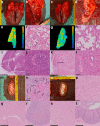COVID-19 pathophysiology may be driven by an imbalance in the renin-angiotensin-aldosterone system
- PMID: 33893295
- PMCID: PMC8065208
- DOI: 10.1038/s41467-021-22713-z
COVID-19 pathophysiology may be driven by an imbalance in the renin-angiotensin-aldosterone system
Abstract
SARS-CoV-2 uses ACE2, an inhibitor of the Renin-Angiotensin-Aldosterone System (RAAS), for cellular entry. Studies indicate that RAAS imbalance worsens the prognosis in COVID-19. We present a consecutive retrospective COVID-19 cohort with findings of frequent pulmonary thromboembolism (17%), high pulmonary artery pressure (60%) and lung MRI perfusion disturbances. We demonstrate, in swine, that infusing angiotensin II or blocking ACE2 induces increased pulmonary artery pressure, reduces blood oxygenation, increases coagulation, disturbs lung perfusion, induces diffuse alveolar damage, and acute tubular necrosis compared to control animals. We further demonstrate that this imbalanced state can be ameliorated by infusion of an angiotensin receptor blocker and low-molecular-weight heparin. In this work, we show that a pathophysiological state in swine induced by RAAS imbalance shares several features with the clinical COVID-19 presentation. Therefore, we propose that severe COVID-19 could partially be driven by a RAAS imbalance.
Conflict of interest statement
The authors declare no competing interests.
Figures








Similar articles
-
Intrinsic disorder perspective of an interplay between the renin-angiotensin-aldosterone system and SARS-CoV-2.Infect Genet Evol. 2020 Nov;85:104510. doi: 10.1016/j.meegid.2020.104510. Epub 2020 Aug 24. Infect Genet Evol. 2020. PMID: 32853823 Free PMC article. Review.
-
SARS-CoV-2, ACE2 expression, and systemic organ invasion.Physiol Genomics. 2021 Feb 1;53(2):51-60. doi: 10.1152/physiolgenomics.00087.2020. Epub 2020 Dec 4. Physiol Genomics. 2021. PMID: 33275540 Free PMC article. Review.
-
Understanding the renin-angiotensin-aldosterone-SARS-CoV axis: a comprehensive review.Eur Respir J. 2020 Jul 9;56(1):2000912. doi: 10.1183/13993003.00912-2020. Print 2020 Jul. Eur Respir J. 2020. PMID: 32341103 Free PMC article. Review.
-
Angiotensin-converting enzyme as a new immunologic target for the new SARS-CoV-2.Immunol Cell Biol. 2021 Feb;99(2):192-205. doi: 10.1111/imcb.12396. Epub 2020 Oct 7. Immunol Cell Biol. 2021. PMID: 32864784 Review.
-
Serum ACE2, Angiotensin II, and Aldosterone Levels Are Unchanged in Patients With COVID-19.Am J Hypertens. 2021 Apr 2;34(3):278-281. doi: 10.1093/ajh/hpaa169. Am J Hypertens. 2021. PMID: 33043967 Free PMC article.
Cited by
-
Network-Based Prediction of Side Effects of Repurposed Antihypertensive Sartans against COVID-19 via Proteome and Drug-Target Interactomes.Proteomes. 2023 Jun 8;11(2):21. doi: 10.3390/proteomes11020021. Proteomes. 2023. PMID: 37368467 Free PMC article.
-
Preeclampsia in the Context of COVID-19: Mechanisms, Pathophysiology, and Clinical Outcomes.Am J Reprod Immunol. 2024 Aug;92(2):e13915. doi: 10.1111/aji.13915. Am J Reprod Immunol. 2024. PMID: 39132825 Free PMC article. Review.
-
Reduced circulating FABP2 in patients with moderate to severe COVID-19 may indicate enterocyte functional change rather than cell death.Sci Rep. 2022 Nov 5;12(1):18792. doi: 10.1038/s41598-022-23282-x. Sci Rep. 2022. PMID: 36335131 Free PMC article.
-
SARS-CoV-2: One Year in the Pandemic. What Have We Learned, the New Vaccine Era and the Threat of SARS-CoV-2 Variants.Biomedicines. 2021 May 27;9(6):611. doi: 10.3390/biomedicines9060611. Biomedicines. 2021. PMID: 34072088 Free PMC article. Review.
-
Molecular Epidemiology of SARS-CoV-2: The Dominant Role of Arginine in Mutations and Infectivity.Viruses. 2023 Jan 22;15(2):309. doi: 10.3390/v15020309. Viruses. 2023. PMID: 36851526 Free PMC article.
References
Publication types
MeSH terms
Substances
LinkOut - more resources
Full Text Sources
Medical
Miscellaneous

